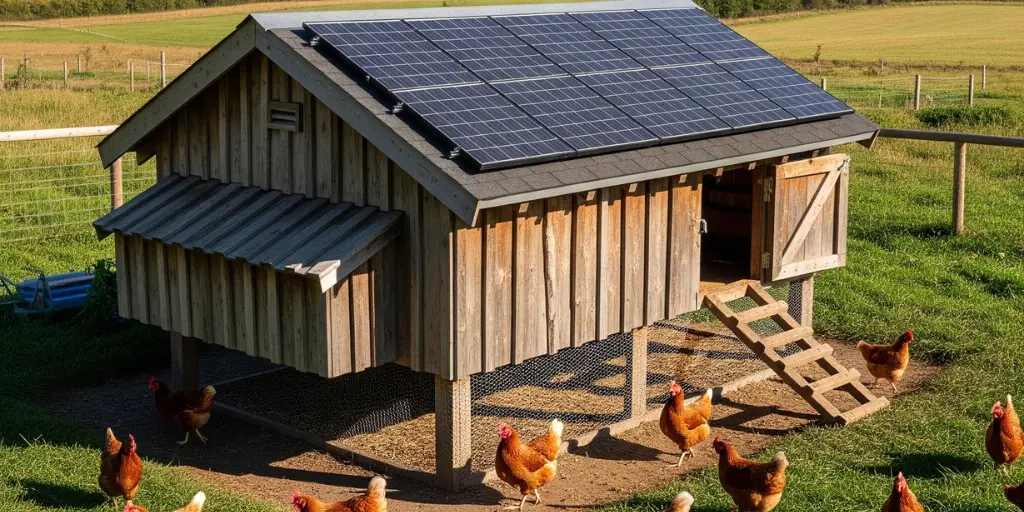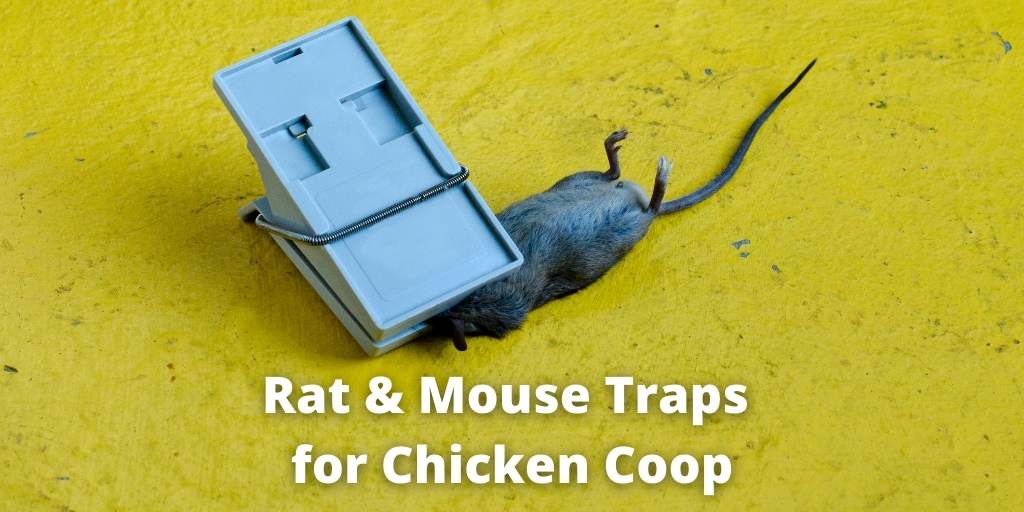Do you want to build a solar-powered chicken coop in your backyard?
Are you ready to make your chicken coop environment-friendly by using solar energy?
If yes, this guide will help you build one.
Introduction to Solar-Powered Chicken Coops
Solar-powered chicken coops are now a part of sustainable and cost-effective solutions in backyard farming.
By using solar energy, you can make your chicken coop environment-friendly and smart.
A chicken coop that runs on solar energy comprises solar panels, battery storage systems, and smart monitoring technology.
These are efficient and provide continuous essential lighting, ventilation, temperature control, and safety equipment.
Chicken raisers can set up solar power in both small and large-sized chicken coops.
There are a few excellent benefits of adding solar power to chicken coops. They are:
- It decreases operational expenses by up to 70%.
- Provide lighting and power 24/7 in the chicken coop.
- Ecofriendly.
- Keep running equipment like a brooder, lights, automatic coop doors, and heated base drinkers without interruption.
So, are you interested in installing solar modules in our chicken coop?
Below, we have explained the characteristics, setup, and best practices of a solar-powered coop system.
How is Solar Power Used in Today’s Poultry Farming?
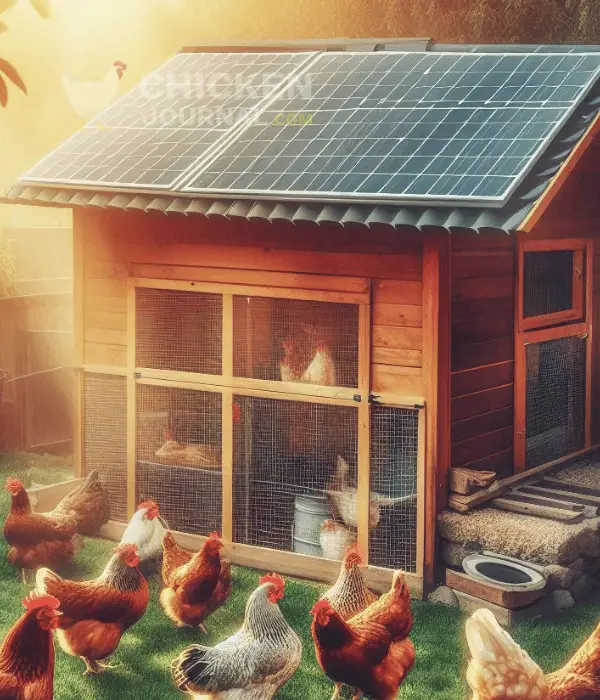
Using solar power in modern poultry farms and backyard coops saves money and is more sustainable.
Farmers are switching to solar power because it’s cheaper than other energy sources.
The Advantages of Integrating Solar Power into Poultry Farms
Poultry farms running on solar power easily handle lights and ventilation fans and keep the right temperature.
This renewable energy uses the sun’s photon energy, notably reducing electricity bills while creating an optimal environmental scenario for birds.
Adding solar panels to chicken coops also provides a continuous power supply. The systems work all day and night, which is good for your chickens.
Effects on the Environment and the Economy
For our environment and economy, it’s a plus point because it decreases the carbon footprint.
In the new generation of poultry farming, using solar power has increased the savings by about 75% because it decreases greenhouse gases.
Solar energy is also a bonus for poultry raisers because most governments provide subsidies and incentives to those using solar panels.
You may need to invest first, but you will get your money back in 5-7 years. It will help you cut energy costs by about 50-60%.
Technical Considerations for Implementation
The correct sizing of solar energy systems is crucial when implementing them in chicken coops.
Solar system efficiency will depend on coop size, bird population, and energy consumption patterns.
Farmers can more easily optimize panel placement and energy generation with professional help.
Smart monitoring systems, using hybrid solar energy technology, help poultry raisers track energy production and usage in real-time, which improves resource control.
Essential Components of a Solar-Powered Chicken Coop
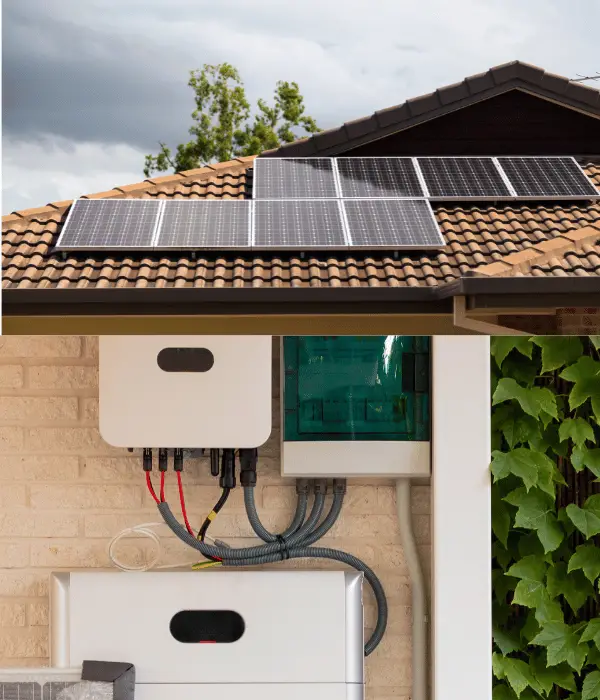
Below are the most common and important parts of a solar-powered chicken coop:
Solar Panels and Power Systems
A constant solar power supply is most important in a system if you are using solar energy.
Panels covering the tops of buildings are the best example of a solar photovoltaic device that transforms sunlight into electricity.
The area of the coop and roof directly affects the electricity consumption of your chicken coop. This is because large flocks use more electricity or resources, and small flocks use less.
A chicken coop mostly uses power because of lighting, ventilation systems, safety equipment like CCTV Cameras, and automated feeding systems.
To get the best results, set solar panels facing south in the Northern Hemisphere at an angle of 30 to 45 degrees. You can use smartphone apps to find the suitable facing side according to your location.
If the solar panels are faced in the right direction the solar panels and inverters will generate more energy to supply and charge batteries.
Solar power systems use charge controllers for voltage regulation and inverters to convert DC to AC power.
Lighting and Climate Control Equipment
As we know lighting conditions significantly affect egg-laying cycles and bird behavior. An example would be LEDs that use solar energy.
They are very energy efficient because you can use multiple watts in one bulb. So, you can reduce the light according to your usage.
Automatic timers and manual switches help to simulate the natural light rhythms of day and night, making it easier for the chickens to lay eggs outside.
Natural temperature control methods can reduce the energy needs of the solar system while keeping your chickens comfortable.
- [Wide Application]: Daily Output 800wh/day under 4…
- [Excellent Performance]: ECO-WORTHY solar panels use…
- [Durable]: Corrosion-resistant aluminum alloy frame, so…
- [Complete and Easy]: The back of the pre-drilled and…
- [Support]: 1 year with 24/7 tech support, if any…
Last update on 2025-09-17 / Affiliate links / Images from Amazon Product Advertising API
Smart Energy Management for Poultry Farms
Using energy wisely in poultry farms is necessary for their survival and profit, as well as sometimes the entire world.
Smart Energy Solutions can help farmers reduce the costs of power operations and maintain the conditions necessary for their chickens.
Monitoring and Control Systems
Today’s poultry farms depend heavily on automated monitoring systems. These smart devices, such as sensors, check the real-time temperature, humidity, and ventilation levels.
Using sensors, maintain consistent poultry house conditions, and minimize energy loss.
Digital controllers keep the temperature within set limits by adjusting the heating and cooling systems as needed.
This not only prevents energy from being used excessively but also ensures that your animals are comfortable.
Energy-Efficient Lighting Solutions
Poultry production depends on the light provided. The life cycle of LED lights, which consume 80% of the energy of traditional bulbs while lasting 10 times longer, is too long.
Programmers can also program them to emulate the sun’s natural cycle, and they provide better light distribution without leaving dark spots.
We should use motion sensors in infrequently accessed areas. If properly placed, these sensors will activate lights only when needed, thus further decreasing unnecessary energy waste.
Ventilation Optimization
Correct ventilation is essential for birds’ comfort and efficient energy use.
Fans that adjust their speeds measure temperature, air quality, and energy consumption to maintain optimal conditions.
70% higher heat recovery with recuperation systems saves companies money.
Regular Maintenance Practices
By creating a regular servicing calendar for your equipment, you can ensure the systems are operating at maximal productivity and reducing electricity waste.
You can also prevent energy waste from blocked or malfunctioning fans, vents, and heating systems.
Every month, checking the air leakages from doors, windows, and openings around vents is essential.
Properly sealed windows and doors may reduce heating and cooling costs by as much as 15 percent.
Environmental Impact and Sustainability
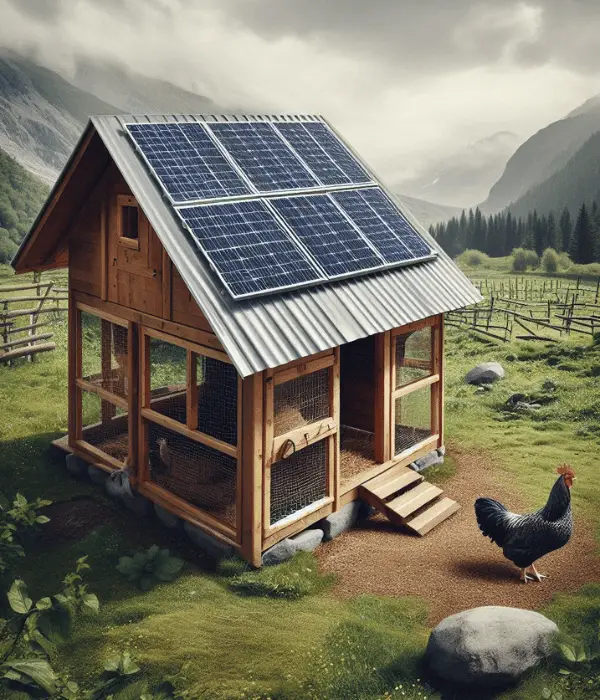
Reducing Carbon Footprint
Poultry farms using solar power will see a significant difference between fossil fuels and renewable energy.
Using clean, natural energy, chicken farming will reduce carbon emissions and improve coop conditions.
These green technologies are also key to stopping climate change from overwhelming our communities.
Resource Conservation
We source solar energy from nature. Also, they replace non-renewable power sources, saving the non-renewable part of the energy source for future generations.
The system can also store the excess energy, meaning no energy will be wasted.
Eco-Friendly Waste Management
Solar-powered ventilation and waste management improve poultry environments, making them cleaner and less frightening.
These systems reduce environmental pollution and create composting opportunities through organic waste recycling.
This circular approach turns waste into valuable resources for sustainable agriculture.
Long-Term Environmental Benefits
Using solar technology in poultry farming can reap immediate and long-term environmental benefits.
Solar panels typically last 25-30 years and actively contribute to environmental benefits.
Their low maintenance and zero emissions also position them as the best option for long-term environmental sustainability.
Supporting Biodiversity
Eco-friendly solar farming provides dual benefits through sustainable agriculture.
First, they’re quieter, minimizing or removing animal exposure to noise pollution.
Second, the quiet operation of the solar systems creates a more peaceful atmosphere for both the farm animals and local wildlife.
This balance will preserve the local ecosystem and ensure poultry farmers’ productivity.
Cost Analysis and ROI
- 【POWERFUL DC to AC CONVERTER】: This car power…
- 【PURE SINE WAVE INVERTER】: The power inverter…
- 【INTELLIGENT LCD DISPLAY】: This 2000Watt inverter…
- 【POWER YOUR EXPECTATIONS】: The inverter 12V to 110V…
- 【MULTIPLE SAFETY PROTECTIONS】: Pure sine wave…
Last update on 2025-09-17 / Affiliate links / Images from Amazon Product Advertising API
Investing in solar-powered poultry coops is a significant decision that highlights the financial implications of sustainability.
To evaluate this investment, we need to carefully consider both the costs and the potential long-term benefits, such as energy savings and environmental impact.
This thoughtful approach helps us make informed choices that align with our financial goals and values.
Initial Investment Considerations
Solar-powered poultry coops typically represent initial costs ranging from $5,000 to $15,000, depending on the size and complexity of the system.
The solar energy system comprises solar panels, inverters, batteries for storage, and installation costs.
Although the cost may appear high initially, tax credits and government subsidies covering 26-30% of the initial investment can mitigate it.
Operating Cost Reduction
Solar units keep the monthly cost of electricity at the lowest possible level. Switching to solar energy reduced the energy costs of most poultry farmers by 60-75%.
For an average-sized chicken coop, you can save up to $50-100 on electric bills monthly.
Maintenance and Longevity
Solar equipment has low-level maintenance, and the annual maintenance costs have been the same. They usually average $150-200, which is mainly for cleaning and checks.
Today’s solar panels are here to stay, with their 25-30 year warranty and an 80% efficiency rate even at the end of 20 years. Their long life enables substantial savings accumulation.
Return on Investment Timeline
Most poultry farmers can achieve payback within 4-6 years. Aspects that can be of concern are:
- Operational area electricity pricing.
- The area of solar power incentives that are available to farmers.
- System size and efficiency.
- Energy consumption patterns.
The combination of lowered operating costs and improved property valuation often yields the opportunity to get a 15-20% return on investment yearly.
Implementation Guide and Best Practices
Planning Your Solar-Powered Coop System
Thorough planning is the key to a successful solar installation for poultry coops.
First, assess how much energy you will need, depending on your flock size and essential equipment, such as lighting and automated feeders.
Evaluate sunlight exposure, shade from nearby structures, and seasonal changes in sunlight to see how much solar potential your location has.
That assessment of the situation in the area helps to determine the most favorable location and size of the solar panels.
The comprehensive budget plan must include the initial equipment costs, setup, maintenance, and power backup systems.
You should also learn about government incentives or agricultural grants that reduce costs.
Installation and Maintenance Tips
Panel orientation is one of the most important parts of solar system installation. Most times, panels facing south at a 30-45-degree angle will absorb maximum sunlight.
Proper mounting of the panels is also necessary, high enough to protect them from ground animals or wild creatures.
Install a reliable battery storage system to ensure energy access at night and during cloudy weather. Deep-cycle batteries, specifically designed for solar power, work best and last a long time.
Doing periodic maintenance:
- Keep electrical parts and tables clean.
- Perform a scrutinizing inspection of the electrical connections.
- Maintain the battery fluid levels within the normal range and observe the charging patterns.
- Check cables and connectors; note any damage.
- Fill in the maintenance details for the warranty.
Take a small generator as a backup solution so that it can still operate regardless of whether the sun is low, needs maintenance or during cloudy days.
Future Trends and Innovations
- Charge Up in a Flash: Achieve 80% battery capacity in…
- A Decade of Power: Trust in a decade-long journey with…
- Powerhouse Versatility: The Anker SOLIX C1000’s…
- Harness the Sun’s Energy: Embrace an eco-conscious…
- Personalized Charging Experience: Customize charging…
Last update on 2025-09-17 / Affiliate links / Images from Amazon Product Advertising API
Innovative ideas are transforming solar-powered chicken coops, potentially revolutionizing agriculture towards sustainability. Let us look at these upcoming trends that will affect the future of eco-friendly poultry management.
Smart Monitoring Systems
Automated systems and IoT-based sensors now let us monitor solar-powered coops more effectively.
These intelligent systems send data to the chicken raiser in real time on energy consumption, temperature, and system performance, to name a few.
Thanks to mobile apps, farmers can now manage situations by getting real-time alerts and making quick data-driven decisions to ensure optimal conditions for their birds.
Energy Storage Solutions
Battery technology has made impressive progress, and it is now possible to introduce new high-capacity storage options that are both affordable and efficient.
Modern batteries use lithium-ion and solid-state technologies to improve energy-intensive farm operations, even at night or on cloudy days.
Integrated Solar Design
Cool new designs put solar panels into the chicken coop, collecting more energy and keeping the chickens cool and warm according to weight.
Some systems even go the extra step of using transparent solar panels that allow natural light to pass through while generating electricity.
AI-Powered Optimization
AI is transforming agricultural practices in some areas, including photovoltaic system management on poultry farms.
It can determine daily/weekly energy needs using weather forecasts, current flock size, and yearly business decisions.
AI’s deep learning and computer technology give farmers better tools, making them more intelligent.
These advanced features mean better solar energy planning and fewer wasted resources on the farm area.
Sustainable Materials
In the long term, solar-powered chicken coops will include environmentally friendly building materials that make energy use greener.
New composite materials and the use of recycled components are already being explored. These materials have various benefits, including improved insulation, and many of them are benign for the ecosystem.
These materials are an integral part of solar systems, thus creating sustainable farming solutions that are hardly environmentally harmful.
FAQs
What is the average payback period for installing solar panels on a poultry coop?
The payback period is typically between 4 and 7 years because of factors such as energy consumption, local electricity rates, and incentives, which are decided locally by individuals themselves. Only afterward will you reap considerable financial benefits and energy autonomy, with no further investment needed for procedures in the event of endless energy.
Can solar-powered coops function effectively during cloudy days or winter months?
Indeed, solar-powered equipment can work even when it is cloudy on winter days by utilizing a battery storage system that stores other energy. Recent advances in solar panel technology allow them to produce between 10% and 25% of their regular output, even under cloudy circumstances. Thus, they provide sufficient power throughout the day for the critical kitchen functions needed for a panel.
What are the effects of solar energy on poultry health and productivity?
Solar-powered systems ensure a consistent and steady supply of air, light, and temperature control, which is the main reason for improved bird well-being. In this way, stressors become small, so converting nutrients into meat is more straightforward. Plus, the frequency of egg production rises when kept under the right climatic conditions.
What is the upkeep for solar panels in poultry coops?
The upkeep for solar panels and their surroundings consists of minimum application items: once a quarter, they shall be dusted off and wiped from any dirt using a soft cloth or some other cleaning aid; once a year, the electrical wiring and the various connecting parts are looked after as well as the uninterrupted check of battery systems for errors and excessive discharges. In the case of solar installation, customers usually have a warranty period of 25 years. Thus, proper care and handling of food-grade materials are the main conditions for effectively working with batteries.
Is there any financial assistance for farmers who want to implement PV systems in agriculture?
Sure! Governments in many countries provide various forms of support, such as tax incentives, grants, or subsidies, for solar PV installation in agriculture. Such programs may help you afford 26-30% of the total cost of installation, thus being a step closer to sustainable energy and clean technology adoption. Furthermore, these systems are the key to separating installations from the competition and FPGAs on the market.
How do solar-powered coops play a role in organic certification and marketing?
Solar-powered coops can help farms receive organic and environmental certifications and valuable value-added marketing sources. The green factor of production speaks to eco-conscious consumers, and thus, subjecting poultry products to such scrutiny might yield our acceptance of high-priced ones.
Conclusion
In sustainable poultry farming, opting for solar-powered coops is the future. They offer eco-friendly benefits and are a strategic investment for your business.
We can lower costs, achieve energy independence, and create a greener, more sustainable agricultural sector by introducing solar technology.
Switching to solar power for your chickens might seem like a big deal, but it’s worth it. Modern poultry farming is changing because solar power is cheaper and greener, giving us a reliable energy supply and efficient operations.
You can start sustainable poultry management today. Solar is efficient and scales well, no matter the size of your business.
Going green isn’t just good farming; it’s building a better future when you develop your solar-powered chicken coop and farm.
